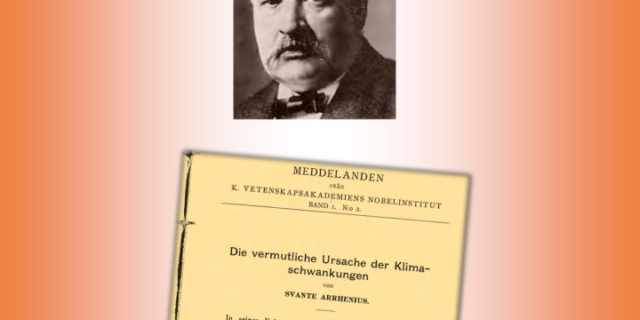
The Probable Cause of Climate Fluctuations –
Svante Arrhenius
A Translation of his 1906 Amended View of “Global Warming”
Original title: “Die vermutliche Ursache der Klimaschwankungen”
Meddelanden från K. Vetenskapsakademiens Nobelinstitut Band 1 No 2.
A Friends of Science Foreword
Svante Arrhenius’ 1896 calculations on the effect of carbon dioxide (CO2) on global warming are frequently cited by proponents of Anthropogenic Global Warming as evidence that it was known more than 100 years ago that significant or catastrophic warming would occur due to a rise in CO2. Arrhenius first paper, in 1896, was written in a period when the world was just re-covering from the Dalton minimum (1790-1830), a period of low solar activity, many volcanoes and global temperatures about 1 ° C degree lower than that of the subsequent 1900’s. His paper was directed mainly towards determining the influence of carbon dioxide—which he called ’carbonic acid’ — on global cooling. Warming was considered as a corollary. The temperature change in the event of doubling CO2 concentration in the atmosphere was predicted by Arrhenius’ first published paper on the topic, to be potentially as high as 5 or 6 °C.
Much discussion took place over the following years between colleagues, with one of the main points being the similar effect of water vapour in the atmosphere which was part of the total figure. Some rejected any effect of CO2 at all. There was no effective way to determine this split precisely, but in 1906 Arrhenius amended his view of how increased carbon dioxide would affect climate. He thought the effect would be much less in terms of warming, and whatever warming ensued would be beneficial. He published a paper in German. It was never translated at the time or widely distributed, though many European scientists knew of it and read it.
What follows is the 2014 Friends of Science Society English translation of Arrhenius’ 1906 paper. http://www.friendsofscience.org/assets/documents/Arrhenius%201906,%20final.pdf
The paper makes difficult reading because of the numerous uncertainties involved and the lack of scientific resources that we today would consider normal. But one can conclude that he low-
ered his estimates of maximum warming by several degrees. The IPCC has now lowered its estimates as well to be within range of Arrhenius’ revised view. This would give the range as 1.6 to 3.9 °C, but the same qualifiers persist.
A number of physicists were struggling to define all of this throughout the first half of the 20th century. Researchers like Beck, Callendar, Jaworowski and others for decades even disagreed about the actual physical CO2 measurements themselves.
Contrary to popular belief of today, CO2 concentrations remain highly variable in the different levels of the atmosphere, by geographic location and by season.
Apart from the fact that that changes in CO2 concentrations follow temperature changes throughout geologic time, it is ironic that the effect of water vapour in the atmosphere is still a hot topic: Does it cause a positive or a negative feedback in the “greenhouse”? Upper Troposphere water vapor is a major ‘wild card’ in global warming theory. As recently as 2010, NOAA found that Stratospheric water vapour is also a ‘wild card’. One hundred years later—so much for settled science.
The Probable Cause of Climate Fluctuations –
Svante Arrhenius
A Translation of his 1906 Amended View of Global Warming
In his Bakerian Lecture of February 7, 1861, * Tyndall presented the results of an analysis of the relatively strong absorption of heat radiation by water vapour and carbon dioxide. On the basis of this analysis, he expressed the view that changes in CO2 and water vapour content of the atmosphere explain all climate changes which had been identified by geological research.
Later I investigated the idea of the thermal influence of atmospheric absorption, which was developed by De Saussure, Fourier and Pouillet about 100 years ago, to further develop it quantitatively, by attempting to calculate how a certain increase in the temperature of the Earth’s surface would be related to a certain fluctuation of the CO2 content of the atmosphere. Since I published my last calculations,* some studies have appeared which apply to this interesting question, which I did not want to leave unmentioned because it could lead to incorrect conclusions.
The first of these studies was done by Koch.* He observed the radiation from a 100 degree heat source that shone on a bolometer shielded between slices of rock-salt plates of various thicknesses. This investigation led Ångström to the conclusion that “at most 16% of the Earth’s radiation was absorbed by atmospheric CO2 and that the total absorption is very slightly dependent on the fluctuations of CO2 , as long as this is not less than 0.2 of what is now available. For this reason, Ångström considers my view, that the possibility that climate fluctuations could depend on a change in the quantity of CO2 in the atmosphere, so unfounded that he did not consider it necessary to investigate it further.*
Ekholm* criticized Koch and Ångström’s conclusions as untenable. This review is confirmed by the new measurements of Ruben and Ladenburg* in which they found that the atmospheric CO2 absorbed approximately 22.5% of the Earth’s radiation and that an increase in the amount of CO2 by 100% leads to an increase in absorption by approximately one tenth. This deviation from Ångström’s statements is attributed to the fact that he and Koch’s radiation source applied relatively higher temperatures (100 – 300 degrees C) and the rock-salt plates were set in the path of the radiation through which their measurements “cannot be readily applied to the Earth’s radiation”.
Some research by Schäfer, which was carried out in the Institute of Rubens, led to conclusions, that were partially not in agreement with Ångström, but on one point he went further by claiming that ‘”changes in the quantity of atmospheric CO2 have absolutely no influence on the Earth’s temperature, as long as the decrease in CO2 remains less than 80% of the previous amount.”* This conclusion is closely related to those of Ångström concerning the temperature effect of CO2, but it is “not permissible”, according to Ru-
bens, while Shäfer’s measurements concerning the ‘short-wave radiation’ of CO2 (λ=2.6 μ and λ=4.4μ) are invalid for ‘long-wave’ terrestrial radiation ( λ max =10μ). Schäfer’s conclusions are indeed also in stark contradiction with the findings of Rubens and Ladenburg.
If all earlier objections, by the latter authors to the warming effect of atmospheric CO2 are cleared away, they seem to want to take a mediating position, by also saying that ”When through a change of 20% in CO2 content of the atmosphere, a very appreciable absorption of earth radiation must occur, namely approximately 1/30 of the amount, then is yet the herewith related context cooling at the Earth’s surface not alone sufficient to allow for an explanation of the start of the Ice Ages” (p.183).
This utterance may well create the impression, as if I would also would have expressed that the 20% reduction of atmospheric CO2 would be sufficient to cause the Ice Age, i.e., to lower the temperature of Europe by 4-5 degrees C. To prevent such an impression from taking hold, I wish to point out that under the old calculations, a decrease in the amount of CO2 by 50% would cause a decrease in temperature of 4 degrees C (1897) and 3.2 degrees C (1901), respectively.
The view that a decrease in atmospheric CO2 could explain the temperature of an Ice Age is not proved more untenable, than by showing that the complete disappearance of CO2 from the atmosphere would not be sufficient to produce a decline in temperature of 4-5 degrees C.It is now easy to estimate how low the temperature would be reduced if the radiation of the Earth would increase in a ratio 1 to 0.775, i.e. by 29%, which to some extent, corresponds approximately to the data of Rubens and Landenburg. A rise in radiation of 1% corresponds to a temperature reduction of 0.72 degrees C, (= 1/4 x 1/100 x 288, since the average absolute temperature of the Earth’s surface is assumed to be 15 degrees C = 288 degrees absolute). One could, therefore, assume a temperature reduction of approximately 20.9 degrees C as a consequence of the disappearance of CO2 from the atmosphere.
A more detailed account of the low emission of CO2 is taken into account, the details of which are in my 1901 research.* Of the 22.5% of the Earth’s radiation which is absorbed by the atmospheric CO2 in the present state, 3.8% is re-emitted from the CO2 into the atmosphere, so that the real reduction of the Earth’s radiation would be 18.7%. Rather than the current temperature of 15 degrees C = 288 degrees absolute, we have, with the disappearance of CO2, an absolute temperature T, where:
T4 : 288 4 = (1 – 0.187) : 1
whereby T = 273.4 abs. = 0.4 degrees C
The current quantity of CO2 would then raise the temperature of the Earth’s surface to 14.6 degrees C; its disappearance from the atmosphere , would consequently cause a three times greater temperature reduction, which is characteristic of the Ice Age.
In a similar way, I calculate that a reduction in the amount of CO2 by half, or a gain to twice the amount, would cause a temperature change of – 1.5 degrees C, or + 1.6 degrees C, respectively.
In these calculations, I completely neglected the presence of water vapour emitted into the atmosphere. This acts in two ways: In part, the water vapour reduces the radiation in the same way as does the CO2, whereby the absorption of CO2 comprises a larger fraction of the earth’s radiation then if the water vapour would be removed from the atmosphere. In part, the temperature causes an increase in water vapour emitted into the atmosphere, on account of an increase in the quantity of CO2, with the subsequent rise in temperature.
To estimate these two influences, one has to envisage the heat absorption of water vapour, both in respect to the Earth’s radiation, as well as with respect to solar radiation. We know far less about the heat absorption by water vapour than we know about heat absorption by CO2. Ekholm has researched all the present observations to calculate the absorption of terrestrial radiation by water vapour. The main material is provided by
Langley’s observations regarding the absorption of heat radiation of the moon at various water contents of the atmosphere. The water content corresponds to an irradiated water layer of 0.72 – 5.0 cm thickness. For this amount of water vapour, Ekholm found, while assuming a warming increase of 15 degrees against a black background of – 80 degree radiating black body, an absorption of 33 resp. 66.4 %. When calculating the absorption of smaller amounts of water vapour, Ekholm used Bouguer’s formula. This calculation could be regarded as justified by the analysis of Fowle* if Langley has used a sufficiently small gap (according to Fowle 10”-15”). This does not seem to be the case. In any case, the radiation groups included in Langley’s tables had a width of 15 arc minutes. There is, therefore, no doubt that a use of Bouguer’s formula on Langley’s data produced too high an absorption at high water vapour content, and on the other hand, produced too low and absorption at low water vapour content of the atmosphere. Tyndall’s findings*, that the smallest amount of water vapour sufficed to elicit a strong absorption of radiant heat, are in contradiction with the results of the application of Bouguer’s formulas used with Langley’s data.
For the extrapolation of absorption values for low amounts of water vapour, I have assumed from Rubens and Ladenburg’s findings for CoO2, that with correctly obtained data, one can use the following formula:
Log A = K1 + K2 log w
where A = absorption (in fractions)
W = quantity of water vapour
If one introduces the above given values, one obtains: K1 = -0.438; K2 = 0.372
Using the same small table, the variation of A to w can be calculated.
w= 0.001; 0.002; 0.005; 0.01; 0.02; 0.05; 0.1; 0.2; 0.5; 1; 2; 3; 4; 5; 6; 8cm
A= 2.9; 3.7 ; 5.2 ; 6.7; 8.7; 12.0; 15.5; 20.0; 28.2; 36.5; 47.2; 54.8; 61.6; 66.4; 71.0; 79.1 %
Under the assumption that water vapour is distributed in the atmosphere as indicated by the calculation by v. Bezold from the results of the German air ships, I have determined the decrease by water vapour of the Earth’s radiation.
Because of the high concentration of water vapour in the lower air layers, the radiation is not reduced by the action of the water vapour in the same proportion as it is by the action of CO2. The calculation shows that under the conditions of the quantity of water vapour in our atmosphere, almost exactly 1/3 of the radiation absorbed by the atmospheric water vapour is retained. The average water vapour content of the whole atmosphere corre-
sponds to approximately an absorbent layer 4 cm in length. Thus the water vapour would reduce the Earth’s radiation by 1/3 x 61.6 = 20.5%.
If one uses this correction, one finds that with a change in the quantity of CO2 in the ratio of 1:2, the temperature of the Earth’s surface would be altered by 2.1 degrees. It is assumed that the radiation that is absorbed by the water vapour is not influenced by the CO2.*
Added to this is still the increased heat protection through the uptake of water vapour. The water vapour in the atmosphere does not only keep back the Earth’s radiation, but also absorbs a large part of the solar radiation. This last circumstance works in opposite directions, but not nearly as vigorously as the former. For this related correction, I have
used the data of Ångström and Schukewitsch. * The calculations show that a doubling of the quantity of water vapour in the atmosphere would correspond to raising the temperature by an average of 4.2 degrees C.
For this disclosure, one could calculate that the corresponding secondary temperature change, on a 50% fluctuation of CO2 in the air, is approximately 1.8 degrees C, such that the total temperature change induced by a decrease in CO2 in the air by 50% is 3.9 degrees (rounded to 4 degrees C).
My first calculation of this figure gave a slightly higher value – approximately 5 degrees C. In this older calculation, the influence of CO2 was too large, for that the influence of water vapour was valued too low, as Ekholm already commented. This situation was caused in general from Langley’s data, where the quantity of CO2 increases with the quantity of water vapour, so that a slight shift in favour of one results in experimental errors. However, the resulting errors compensate each other for the most part.
I have not considered it necessary to make a more detailed statement with the present data concerning the heat absorption, since these must be completed in many areas before it is worthwhile to make wider-sweeping calculations. I just wanted to show that the newer findings of Rubens and Ladenburg lead to approximately the same results to which I have arrived by calculations of older findings.The new calculations, as also the older
ones, can naturally provide little more than show the large influence of approximately 30%.
We assume from the leading geologists that the temperature during the Ice Age was 4-5 degrees lower, while on the other hand in the Eocene it was 8-9 degrees higher than it is now. There was also a decrease in the current quantity of CO2 at about 50-60% at the time of the Ice Age, which would correspond to a rise of the same to four to six times the amount in the Eocene.
In a large work, known as the Equator Question, Kreichgauer* has taken up the old idea that the Ice Ages were explained by strong shifts of the poles on the Earth’s surface. He thinks of the explanation in the following way:
We assume that we have a celestial body rotating around its axis which is composed of many layers with different specific gravity. These are then layered so that the deepest has also the heaviest specific weight and so on, so that in the end the outermost layer is made up of the lightest component of the celestial body. Due to the effect of the rotation in each
layer, its depth at the equator had to be larger than at the poles. because of the increasing centrifugal force this difference had to be the greatest in the outermost layer.
This influence is valid so long as the layers are liquid. On the Earth, the top layer is solid (apart from the air and sea which have relatively minor mass) and it ranges up to a certain depth where it melts because of the high temperature. It is now generally believed that the increase in temperature with depth is everywhere approximately equal, therefore the Earth’s crust had to be the same thickness everywhere if the Earth’s surface is to be the same everywhere. Because the temperature at the poles is somewhat lower than at the equator, the Earth’s crust at the poles is probably somewhat thicker than at the equator.
According to the equilibrium condition, the top layer at the equator should be the thickest. Consequently there is no equilibrium, instead the solid crust has a tendency to shift towards the equator. Due to the non-symmetrical distribution of the continents, the driving force is not symmetrically distributed. Kreichgauer says that, e.g., according to the predominance over the landmass in the Northern Hemisphere and in the old continent, a shift of the Earth’s crust in the direction North Pole towards the Caucasus is now taking place.
A consequence of this would be that the North Pole of the stationary Earth’s axis now moves in the opposite direction, namely from the North Pole towards Alaska.
In this section, it is assumed that the outermost layer of the Earth’s system has a lesser specific gravity than the next layer of molten parts. However, this is not certain to be the case. Barus has observed a contraction of 3.9% for the solidifying of Diabase.. Under
higher pressure, the contraction is smaller. By the cooling down of the Earth’s crust it will become denser. This greater density is compensated by the fact that light eruptive rock types, such as granite make up the main mass of the crust.
It is, therefore, hard to say whether the specific weight of the crust is greater or lighter than the next layer, the magma. One cannot say for certain that, therefore, the continents themselves will proceed to move towards the equator. One noticed no appreciable shift of the poles. The position has been accurately enough described, with an irregular curve
about its central position with the largest distance of about 10 m.
According to Kreichgauer’s estimate, the North Pole must have moved approximately 6,000 km since the glaciation of North America. Kreichgauer estimates the times for this to have been about 10,000 years, an average movement of 600 m/year. If one then takes a 10 –fold length of time since the freezing of North America, which is an unusually high estimate, one finds a pole shift of 60 m/year, which is at least a hundred times greater than what is observed today. Kreichgauer’s assumption is, therefore, extremely unlikely. According to Kreichgauer, the North Pole moved since the Silurian from today’s equator to its present position.
In a recently published memoir, Becker indicated that the majority of the boundaries of the great ocean depths, which have a very long geological age, lie symmetrical with the Earth’s axis. According to him this signifies that the Earth’s axis, at the building of the earth’s solid crust, had the same relative position as it has at present. This stands in contradiction with Kreichgauer’s opinion.*
10I do not wish to dwell on the many geological difficulties which put Kreichgauer’s hypotheses in question, suffice to f refer to the physical and geophysical data that leave them very unlikely and insufficiently justified.
Against the carbon dioxide theory, Kreichgauer objects saying that animal life could not tolerate higher CO2 concentrations. To highlight in contradiction to this, animals can very well tolerate CO2 concentrations in the air of 1% or about thirty times the present amount, and such high concentrations are not needed to explain the climate warming observations.
Reference is made to the work of Chamberlin* and Frech* regarding the possibility of combining the carbon dioxide theory with geological facts.
______________
NOTES AND REFERENCES
* Newly published in John Tyndall: Contributions to molecular physics, London 1872.
The citation is on p. 40.
* S. Arrhenius: Phil. Mag.(5) 41. 237, April 1896. Bihang der Stockh. Ak. d. Wiss. Bd. 22
Abth. 1 No 1 1896, Drudes Annalen d. phys. Bd. 4, 690,1901, Öfversigt d. Stockh. Ak.1901, No 1, p.55 & 56.
* J. Koch: Öfversigt der Stockh. Ak. 1901, 475
* K. Angström: Drudes Annalen d. Physik B. 3. p. 724. 1900.
* N. Ekholm: Meteorol. Ztschr. 1902 (Nov.) p. 490-494
*H. Rubens und E. Ladenburg: Verh. d. deutschen phys. Ges. VII. p. 171-183, 1905
* C. Schäfer: Inaugural diss. p. 15; auch: Drudes Annalen 16, 93, 1905.
* Öfversigt der Stockholmer Ak. 1901 No 1, p.41 & ffg.
In the calculation it is assumed that the decrease in temperature above 10,000 m proceeds at half the rate as required by the adiabatic rules.
* F. E. Fowle: Smithsonian Miscellaneous Collections Vol.47. No 1468. 1904. P.1
* J. Tyndall: op.cit., p. 39, 75.
* This assumption is perhaps not totally valid, in that perhaps some spectral portions in the large absorption band of CO2 are also affected by water vapour. This effect of water vapour seems never the less to be very weak, if it exists at all. Neglect of this fact could be more than offset by the effect of ozone, hydrocarbons etc, which is still very little known and not included in the calculation.
* K. Angström: Drudes Annalen 3. 730. 1903
* D. Kreichgauer: Die Aequatorfrage in der Geologie Missionsdruckerei, in Steyl, 1902.
* George Becker: Present problems of geophysics, American Geologist Bd 35 p.8. 1905
* T. C. Chamberlin: Journal of Geol., Vol 5 No7.p. 680 & Vol. 6. No 6, p.6o9,; 1897/8.
* Frïtz Frech: Zeitschrift d. Ges. f. Erdkunde 1902, pp.611-629 & 671-693.



